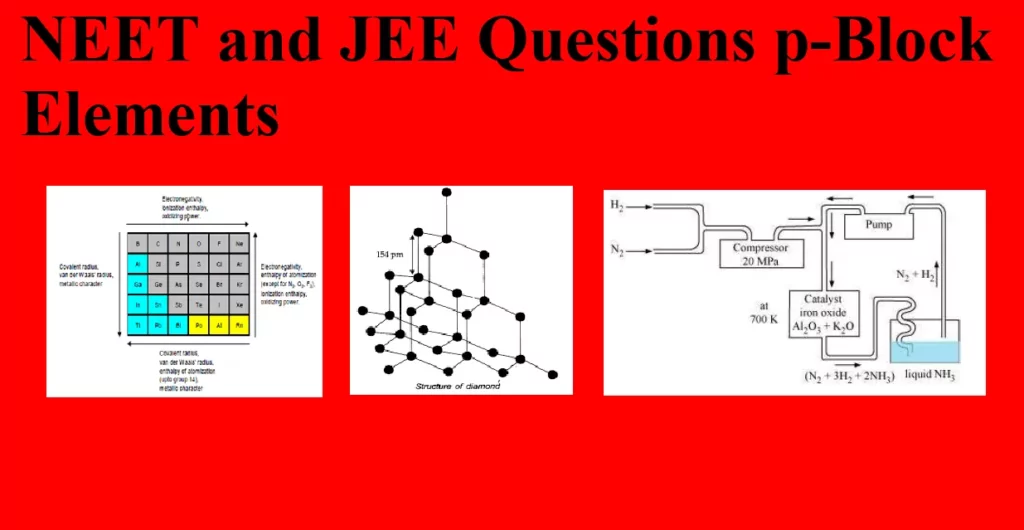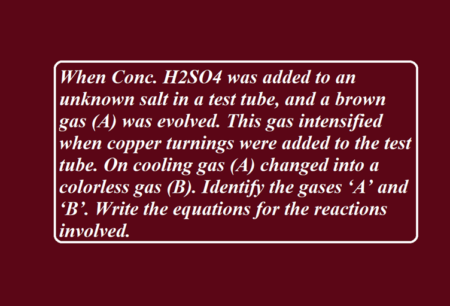NEET and JEE Questions p-Block Elements
Que 1. Which of the following elements does not form stable diatomic molecules.
(a) Iodine (b) Phosphorus
(c) Nitrogen (d) Oxygen
Ans 1. (b) Phosphorus
Explanation: Phosphorous forms tetra atomic molecule it does not form stable diatomic molecule whereas the other given elements form stable diatomic molecules(Due to larger atomic size P does not form pi bonds and so it exists as a tetra-atomic molecule in which each P atom is bonded with 3 other P atoms by 3 sigma bond. But, due to smaller atomic size N forms 1 sigma and 2 pi bonds i.e. triple bonds with another N atom, and exists as a diatomic molecule.
Que 2. Among NH3, PH3, AsH3, and SbH3 which one is a stronger reducing agent?
(a) NH3 (b) PH3
(c) AsH3 (d) SbH3
Ans 2. (d)
Explanation: When we go down the group the size of the atom increase also the distance between The metal hydrogen bond increases in hydrides. So the strength of the metal hydrogen bond decreases therefore hydrogen is easily released. A reducing agent is one that supplies hydrogen atoms.
Que 3. The mixed anhydride of nitrogen is
(a) N2O2 (b) N2O4 (c) N2O5 (d) N2O3
Ans 3. (b)
Explanation: Mixed anhydride or double acid anhydride is the compound that reacts with water to form a mixture of two acidic anhydrides.
Two oxides of nitrogen are acid anhydrides; that is, they react with water to form two nitrogen-containing oxyacids.
2NO2 + H2O ⟶ HNO3 + HNO2
Que 4. Which of the following statements is wrong?
(a) The stability of hydries increases from NH3 to BiH3 in group 15 of the Periodic Table
(b) Nitrogen can’t from dπ-pπ bond.
(c) Single N—N bond is weaker than the single P—P bond.
(d) N2O4 has two resonance structure.
Ans 4. (a)
Explanation: Thermal stability of the hydrides decrease as we go down the group in the periodic table for group 15, due to increase in E—H bond length down the group.
Que 5. Which of the following is the most basic oxide?
(a) Al2O3 (b) SeO2
(c) Bi2O3 (d) Sb2O3
Ans 5. (b)
Explanation: More the oxidation state of the central atom (metal) more is its acidity. Hence SeO2 (O. S. of Se = +4) is acidic.
NEET and JEE Questions p-Block Elements
Que 6. In addition to conc.H2SO4 to a chloride salt, colourless fumes are evolved but in the case of iodise salt, violet fumes come out. This is because
(a) H2SO4 reduces Hl to l2
(b) Hl is of violet colour
(c) Hl gets oxidised to l2
(d) Hl changes to HlO3
Ans 6. (c)
Explanation: Hydrogen iodide is a stronger reducing agent than sulphuric acid so it reduces H2SO4 to SO2 and HI to I2.
Chloride salts when treated with sulphuric acid to give colourless gas due to formation of HCl gas.
NaCl + H2SO4 ⟶ HCl + Na2SO4
Due to the formation of iodine (I2) gas, the violet fumes are evolved during the reaction.
2NaI + H2SO4 ⟶ Na2SO4 + 2HI
Na2SO4 + 2HI ⟶ 2H2O + SO2 + I2
Que 7. Arrange the following in order of increasing acidity H3PO4, H2CO3, HCl, HI
(a) H3PO4, HCl , H2CO3, HI
(b) H3PO4, H2CO3, HCl, HI
(c) H2CO3, H3PO4, HCl, HI
(d) None of these
Ans 7. (c)
Explanation: H2CO3 ˂ H3PO4 ˂ HCl ˂ HI
Que 8. Producer gas is a mixture of
(a) CO and N2 (b) CO2 and H2
(c) CO and H2 (d) CO2 and N2
Ans 8. (a)
Explanation: A combustible mixture of nitrogen, carbon monoxide, and hydrogen, generated by passing air with steam over burning coke or coal in a furnace and used as fuel. Also called air gas.
Que 9. Among the following statement which one is true?
(a). NH3 is less soluble than PH3 in water
(b) NH3 is a stronger base and stronger reducing agent than PH3
(c) NH3 has a higher boiling point than PH3 and has a lower melting point than PH3
(d) PH3 is a stronger reducing agent than NH3 and it has a lower critical temperature than NH3
Ans 9. (d)
Explanation: Due to the larger atomic size of P the bond length of the P−H bond is larger and bond dissociation energy is smaller. Hence, PH3 easily gets dissociated to give up H2 gas. Therefore, PH3 acts as a stronger reducing agent than NH3.
Que 10. Which of the following statements regarding N2O4 is not correct?
(a) It is a planar molecule
(b) It is used as a non-aqueous solvent
(c) It involves N—N bond which is shorter than the N—N bond in hydrazine
(d) Ammonium nitrate in N2O4 acts as a base.
Ans 10. (c)
Explanation: Ammonium nitrate in N2O4 acts as a base.
It is a planar molecule.
It involves an N-N bond which is longer than the N-N bond in hydrazine.
NEET and JEE Questions p-Block Elements
Que 11. In which of the following arrangements, the sequence is not strictly according to the property written against it?
(a) CO2 < SiO2 < SnO2 < PbO2 increasing oxidising power
(b) HF < HCl < HBr < HI increasing acid strength
(c) NH3 > PH3 < AsH3 < SbH3 increasing basic strength
(d) B < C < O < N increasing first ionisation enthalpy
Ans 11. (c)
Explanation: NH3 < PH3 < AsH3 < SbH3 increasing basic strength
Que 12. Which one of the following orders is not in accordance with the property stated against it?
(a) F2 > Cl2 > Br2 > I2 ; electronegativity
(b) F2 > Cl2 > Br2 > I2 ; bond dissociation energy
(c) F2 > Cl2 > Br2 > I2 oxidizing power
(d) HI > HBr > HCl > HF acidic property in water
Ans 12. (b)
Explanation: In the case of diatomic molecules (X2) of halogens the bond dissociation energy decreases in the order: Cl2 > Br2 > F2 > I2
The oxidizing power, electronegativity and reactivity decrease in the following order: F2 > Cl2 > Br2 > I2 Electron gain enthalpy of halogens decrease in the following order: Cl2 > F2 > Br2 > I2
The low value of electron gain enthalpy of fluorine is due to the small size of the fluorine atom.
Que 13. In the preparation of compounds of Xe, Bartlett had taken O2 + PtF6 – as a base compound. This is because
(a) both O2 and Xe have the same size
(b) both O2 and Xe have the same electron gain enthalpy
(c) both O2 and Xe have almost the same ionisation enthalpy
(d) both Xe and O2 are gases.
Ans 13. (c) both O2 and Xe have almost the same ionisation enthalpy.
Que 14. Each of the following is true for white and red phosphorus except that they
(a) Are both soluble in CS2
(b) Can be oxidised by heating in air
(c) Consists of the same kind of atoms
(d) Can be converted into one another
Ans 14. (a)
Explanation: White phosphorus, yellow phosphorus, or simply tetra-phosphorus (P4) exists as molecules made up of four atoms in a tetrahedral structure. As the phosphorous molecule is non-polar, so it dissolves in a non-polar solvent like carbon disulfide, CS2.
Que 15. The formation of PH4+ is difficult compared to NH4+ because:
(a) lone pair of phosphorus is optically inert
(b) lone pair of phosphorus resides in almost pure p-orbital
(c) lone pair of phosphorus resides at sp3 orbital
(d) lone pair of phosphorus resides in almost pure s-orbital
Ans 15. (d) lone pair of phosphorus resides in almost pure s-orbital.
NEET and JEE Questions p-Block Elements
Que 16. Which of the following will be formed when HNO2 disproportionate in an aqueous medium?
(a) NH3 (b) N2
(c) NO (d) HNO3
Ans 16. (c, d)
Explanation: HNO2 → HNO3 + NO + H2O
Que 17. Which one of the following reactions of xenon compounds is not feasible?
(a) XeO3 + 6HF → XeF6 + 3H2O
(b) 3XeF4 + 6H2O → 2Xe + XeO3 + 12HF + 1/5O2
(c) 2XeF2 + 2H2O → 2Xe + 4HF + O2
(d) XeF6 + RbF → Rb[XeF7]
Ans 17. (a)
Explanation: XeO3 + 6HF → XeF6 + 3H2O
Que 18. The variation of the boiling point of the hydrogen halides is in the order HF > HI > HBr > HCl. What explains the higher boiling point of hydrogen Fluoride?
(a) There is strong hydrogen bonding between HF molecules
(b) The electronegativity for fluorine is much higher than for other elements in the group
(c) The bond energy of HF molecules is greater than in other hydrogen halides
(d) The effect of nuclear shielding is much reduced in fluorine which polarises the HF molecule
Ans 18. (a)
Explanation: Due to strong H-bonding in HF it has very high BP.
Que 19. Which one is not a property of ozone?
(a) It acts as an oxidising agent in a dry state
(b) Oxidation of KI into KIO2
(c) PbS is oxidised to PbSO4
(d) Hg is oxidised to Hg2O
Ans 19. (b)
Explanation: Oxidation of KI by O3 gives potassium hydroxide, iodine, and oxygen and not KIO2. KI + O3 + H2O ⟶ KOH + O2 + I2
Que 20. Which of the following is not isostructural with SiCl4?
(a) PO43– (b) NH4+
(c) SCl4 (d) SO42–
Ans 20. (c)
Explanation: SiCl4 is tetrahedral as it has four chlorine atoms attached tetrahedrally whereas SCl4 has four chlorine atoms and a lone pair on sulfur which makes its structure see-saw and the remaining molecules are having tetrahedral geometry.
So SCl4 is not isostructural with SiCl4.
ELECTROCHEMISTRY NEET IMPORTANT SOLVED QUESTIONS
https://sciencemotive.com/class-12-chemistry/electrochemistry-neet-important-solved-questions/
NEET and JEE Questions p-Block Elements



